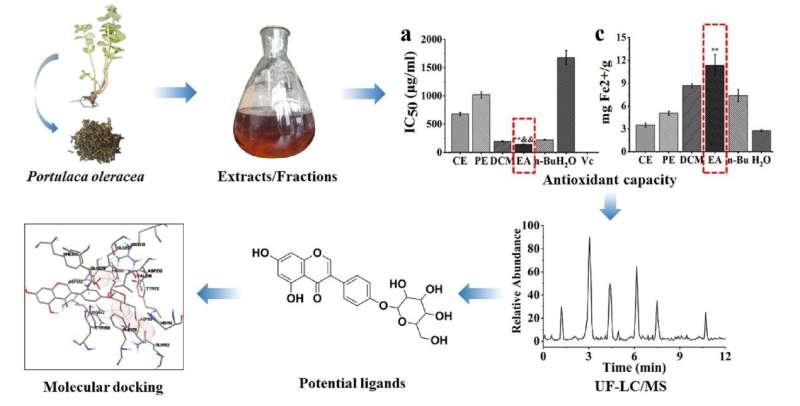Researchers screen potential antioxidant, hypoglycemic and hypolipidemic components from Portulaca oleracea

Portulaca oleracea, a kind of annual herb widely distributed all over the world, is a well-received vegetable and a traditional herbal medicine with plentiful nutrients and manifold pharmacological activities. However, the responsible bioactive compounds of P. oleracea and the underlying mechanisms are far from known.
Ph.D. student Zhang Hui, supervised by Prof. Guo Mingquan at the Wuhan Botanical Garden of the Chinese Academy of Sciences, systematically investigated the antioxidant activities of different parts of P. oleracea via 2,2-diphenyl-1-picrylhydrazyl, 2,2' -azinobis-(3-ethyl-benzthiazoline-6-sulfonic acid radical scavenging and ferric ion reducing antioxidant power assays.
The corresponding total phenol content (TPC) and total flavonoid content (TFC) were also determined by colorimetric method. Results revealed that ethyl acetate (EA) fraction of P. oleracea showed the highest antioxidant activity along with the highest TPC and TFC.
In older to reveal its responsible active compounds, the researchers established a multi-target affinity ultrafiltration coupled to LC/MS method (UF-LC/MS) for the rapid screening of superoxide dismutase (SOD), α-glucosidase, and pancreatic lipase ligands from P. oleracea.
As a result, four ligands from the EA fraction were quickly fished out as potential SOD, α-glucosidase, and pancreatic lipase ligands, respectively. In addition, molecular docking revealed that these potential ligands exhibited strong binding ability and inhibitory activities on those three enzymes.
This study demonstrates that P. oleracea can be used as a natural source of food-derived antioxidants and hypoglycemic agents. Meanwhile, the integrated strategy based on multi-target UF-LC/MS and molecular docking provides a convenient method to explore the bioactive ingredients in P. oleracea.
This research was published in Phytochemical Analysis, titled "Screening and characterization of potential antioxidant, hypoglycemic and hypolipidemic components revealed in Portulaca oleracea via multi-target affinity ultrafiltration LC-MS and molecular docking."
More information: Hui Zhang et al, Screening and characterisation of potential antioxidant, hypoglycemic and hypolipidemic components revealed in Portulaca oleracea via multi‐target affinity ultrafiltration LC–MS and molecular docking, Phytochemical Analysis (2021). DOI: 10.1002/pca.3086
Provided by Chinese Academy of Sciences




















